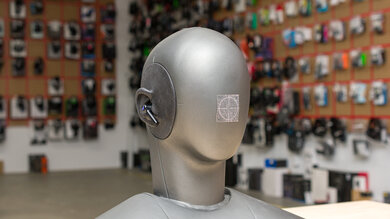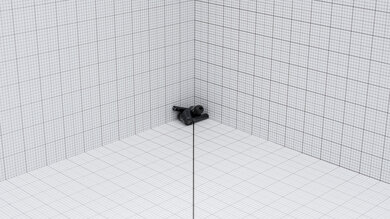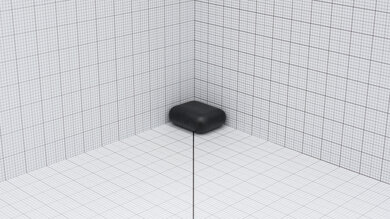The Razer Hammerhead Pro HyperSpeed True Wireless are cross-platform gaming earbuds. Thanks to their USB-C dongle, you can connect them to PCs and consoles like the PlayStation 5 and Nintendo Switch with low latency. They also have noise cancelling (ANC) and have an improved isolation performance compared to other earbuds in this lineup. They even have customizable Chroma RGB lighting if you're into that kind of thing.

Looking for Black Friday savings on your next pair of headphones? We've got you covered! Check out our Early Black Friday 2025 Deals article for what's worthwhile this year.
Our Verdict
The Razer Hammerhead Pro HyperSpeed are decent for neutral sound. They're well-balanced out of the box and deliver enough bass to ensure mixes have warmth, boom, and rumble, but vocals and instruments are a bit thin and hollow due to a dip in the mids. You can fine-tune their sound to your liking using their companion app's graphic EQ and presets. That said, the soundstage they create feels closed-off and not very immersive.
- Customization features like graphic EQ and presets available in app.
- Bad passive soundstage.
The Razer Hammerhead Pro HyperSpeed are very good for commute and travel. These buds are lightweight, decently comfortable, and are easy to take with you on the go, thanks to their small and portable design. They're also noise cancelling buds and can block out the low rumble of bus engines well. Unfortunately, with only their ANC on (no RGB lighting), they last over five hours continuously, which may not be enough to get you through long trips. Their carrying case supplies four extra charges if you need more battery life.
- Stable fit.
- Very good noise isolation performance.
- Five hour continuous battery life.
The Razer Hammerhead Pro HyperSpeed are great for sports and fitness. They have a lightweight and portable design that's easy to take with you on the go. They're also certified IPX4 for resistance against splashes of water. Even though they lack stability fins, once you get a good fit, they're still stable enough for running or working out.
- Stable fit.
- Rated IPX4 for water resistance.
- Five hour continuous battery life.
The Razer Hammerhead Pro HyperSpeed are decent for office use. Although they have a gamer-centric design, you can turn off the RGB lighting to keep them office-friendly. They're also equipped with an ANC system to help cut down chatty coworkers and the hum of AC units around you. They don't leak very much audio at high volumes, either. That said, they don't support multi-device pairing, so you can't stay connected to your PC and smartphone simultaneously. With their ANC on (and lighting off), they also last over five hours continuously, which may not be enough to get you through your day. Their carrying case supplies an extra four charges, though.
- Very good noise isolation performance.
- Good overall mic performance.
- No multi-device pairing.
- Five hour continuous battery life.
The Razer Hammerhead Pro HyperSpeed are alright for wireless gaming. These buds come with a USB dongle that you can use for a fairly low-latency gaming experience on PCs and supported consoles like the PS5. If you're a mobile gamer, they also have Game Mode, which helps lower audio lag over Bluetooth. Their balanced sound is adjustable using their companion app's graphic EQ and presets. They also have customizable RGB lighting, though if you want to have this enabled with ANC simultaneously, then the buds will only last around three hours at a time. Turning off both features brings the battery life upwards of five hours. There are four charges in the case if you need it, though.
- Customization features like graphic EQ and presets available in app.
- Bad passive soundstage.
The Razer Hammerhead Pro HyperSpeed are truly wireless earbuds; you can't use them wired.
The Razer Hammerhead Pro HyperSpeed are decent for phone calls. They have an integrated mic that does a great job of separating speech from background noise, so you'll be heard clearly, even if you're calling from a busy street. The mic's recording quality is decent, too, and while your voice sounds unnatural, it's still easy to understand. The buds are equipped with ANC, too, and can block out a lot of ambient sound across the spectrum, so you can focus on your call, whether you're calling from a train or an office.
- Very good noise isolation performance.
- Good overall mic performance.
- No multi-device pairing.
- Five hour continuous battery life.
Changelog
-
Updated May 14, 2025:
The SteelSeries Arctis GameBuds were added to the Comfort section as an alternative option.
- Updated Jun 27, 2024: Information comparing the ASUS ROG Cetra True Wireless SpeedNova has been added to Noise Isolation and Battery sections.
- Updated Feb 07, 2024: Made a note that the Sony PULSE Explore Truly Wireless support multi-device pairing in Bluetooth connection.
- Updated Dec 06, 2023: We've added a comparison between these headphones and the Sony INZONE Buds Truly Wireless in Battery.
Check Price
Differences Between Sizes And Variants
The Razer Hammerhead Pro HyperSpeed come in one color variant: 'Black', and you can see our model's label here. If you encounter another variant of these headphones, let us know in the forums, and we'll update our review.
Popular Headphones Comparisons
The Razer Hammerhead Pro HyperSpeed are wireless earbuds designed for gaming. They join the Hammerhead lineup but offer a better noise isolation performance than sibling products like the Razer Hammerhead True Wireless Pro and even have customizable Chroma RGB lighting. If you're a PC gamer, you can take advantage of their wireless USB-C dongle, but if you're into mobile gaming, they have a low latency Game Mode to help keep your audio and visuals fairly in sync. They also have a better overall battery performance than the similarly intended EPOS GTW 270 Hybrid Truly Wireless. Unfortunately, they're incompatible with Xbox consoles, so you'll need to look elsewhere if this is your preferred console.
Check out our recommendations for the best earbuds for gaming, the best wireless headsets for gaming, and the best Razer headsets.
The Razer Hammerhead Pro HyperSpeed True Wireless are better earbuds for wireless gaming than the Sony INZONE Buds Truly Wireless. While both buds have similarly comfortable fits and lightweight, portable designs, the Razer have a more balanced sound profile, which you may prefer. They also have better mic performance and better Bluetooth connectivity options as they use the SBC codec by default. In contrast, the Sony only use LE audio, which is newer and has limited compatibility. However, the Sony have a considerably longer battery life.
The Razer Hammerhead Pro HyperSpeed True Wireless are very competent earbuds with Bluetooth and wireless USB dongle connectivity. Their Bluetooth latency is lower than the ASUS ROG Cetra True Wireless SpeedNova over Bluetooth, but their dongle's latency is slightly higher. Both have useful apps, though the ASUS have a couple more options. The ASUS also have about twice the battery life and a bit better noise isolation. That said, the Razer have a smoother sound by default, while the ASUS are much more bassy and excited. You can EQ both earbuds to taste.
The Razer Hammerhead Pro HyperSpeed True Wireless and the Sony PULSE Explore Truly Wireless are gaming earbuds with different strengths. The Razer have ANC, so they can block ambient sound while you play. Their integrated mic has significantly better performance, and they have an app with sound customization features. However, the Sony have lower latency via non-Bluetooth wireless. They also support Bluetooth, so you can listen to audio from your phone and console simultaneously or use them more casually when you're out and about. They also support PlayStation Link, which allows them to connect wirelessly with the PlayStation Portal remote player for PS5.
The Razer Hammerhead Pro HyperSpeed True Wireless are better in-ears than the Razer Hammerhead True Wireless 2021. While both buds are decently comfortable, the Pro HyperSpeed have a more neutral sound profile, which some users may prefer, and their ANC blocks out more background noise. They also come with a USB-C dongle for low-latency gaming.
Test Results

The Razer Hammerhead Pro HyperSpeed look a lot like the Razer Hammerhead True Wireless Pro as they have a black stem design. They're mostly made of shiny black plastic but have Razer's RGB Chroma lighting on the face of the buds. You can customize the lighting to your liking via the companion app. The buds themselves only come in a 'Black' colorway, though.
These headphones are decently comfortable. They fit and feel similarly to other buds in the Hammerhead lineup. The tips don't have a deep in-ear fit and are comfortable once you have a proper seal. They also come in three differently sized pairs to help you get the best fit. The stem is long, which can get in the way, especially if you wear long, bulky earrings. The shape of the buds can also press up against your outer ear after some time. If you don't like stemmed buds and prefer a more comfortable fit, the SteelSeries Arctis GameBuds are a worthwhile alternative.
The Razer Hammerhead Pro HyperSpeed have a good touch-sensitive control scheme. By default, most of the controls can be done by either bud, but you can change them independently if you prefer a different layout. There are voice prompts to let you know when you've registered a command and beeps to let you know when you've reached min and max volume. Unfortunately, if you want voice assistant support, you must swap out one of the other commands. Registering certain commands, like volume control, is also tricky, as the touch-sensitive surface doesn't always recognize the input. Tapping the buds seems loud in your ears, too.
On the left bud:
- Double tap and hold: Lowers the volume.
On the right bud:
- Double tap and hold: Raises the volume.
On either bud:
- Single tap: Plays and pauses audio.
- Double tap: Skips the track forward. Also answers calls or switches to a different call.
- Triple tap: Switches between Bluetooth and the USB dongle.
- Triple tap and hold: Activates 'Game Mode', which is a low latency mode via Bluetooth.
- Hold for a few seconds: Activates ANC. Also rejects calls.
These buds have a somewhat balanced sound profile using the THX EQ preset. They pack an even bass, but dialogue and instruments sound thin and hollow due to dips in the mid and treble range. Their sound is still versatile enough for various audio content, though. If you prefer a different sound, you can fine-tune them using their companion app's graphic EQ and presets.
We had problems getting a good fit into our test rig's ears. As a result, the right five passes show a lot more inconsistencies in audio delivery than the left. However, we don't expect you to have nearly the same issues as us in real-life use. It can take some time to get a good fit, but once they're in, you'll experience consistent sound delivery each time you use them.
These buds have outstanding bass accuracy. The response is very flat and neutral. Although they lack a bit of thump and rumble due to the underemphasized low-bass, they still deliver adequate punch and warmth to help emphasize sound effects like footsteps.
The Razer Hammerhead Pro Hyperspeed have great mid accuracy. The low to mid-mid are underemphasized, which results in a thinner sound with vocals and instruments pushed to the back of the mix. This isn't as noticeable with very dialogue-heavy games, like Disco Elysium, but if there's also a soundtrack and sound effects present in the mix, voices sound recessed. The high-mid is neutral, so vocals and instruments are still adequately bright.
The Razer Hammerhead Pro HyperSpeed have good treble accuracy. The response is underemphasized, resulting in veiled vocals and instruments, while sibilants like cymbals are dull.
The peaks and dips performance of these buds is good. For the most part, the peaks and dips are minor, which means that the headphones can reproduce their sound profile fairly well. That said, a dip in the low-mid affects the right driver more prominently and thins the mix, while a peak in the high-mid makes vocals and instruments sound harsh. A following dip in the low-treble veils vocals and instruments while a peak in the mid-treble makes sibilants like cymbals piercing.
Razer's products tend to have good imaging performances, although some over-ears we've tested, like the Razer Kraken V3, have had issues. Imaging varies across units and indicates a manufacturer's quality control and ergonomics. Our unit's L/R drivers are well-matched in group delay, ensuring tight bass and transparent treble reproduction. They're also matched regarding frequency and amplitude response, which helps ensure a stable stereo image. However, there is some phase mismatch present in the mid-range. This causes lower-range and deeper voices to sound recessed and further away from the center. Conversely, higher-pitched female voices and instruments with a higher frequency range, like pianos, are skewed to the right. The peak in the phase response's low-bass is less thumpy, too, but it's more difficult to spot with real-life content.
The passive soundstage performance of these buds is bad, but that's normal for in-ear headphones. Sound needs to interact with your outer ear to create a wide and immersive soundstage. By design, earbuds bypass your outer ear, so their soundstage seems closed-off and small.
These headphones have THX certification, which the manufacturer advertises to ensure users a balanced frequency response, low distortion, and solid seal for noise isolation. They also have a THX EQ preset found in their companion app. However, both features aren't true 7.1 or multi-channel virtual surround support.
The Razer Hammerhead Pro HyperSpeed's weighted harmonic distortion performance is good. All frequencies fall within good levels, producing clear and pure audio reproduction.
These are the settings used to test these headphones; our results are only valid when used in this configuration.
The noise isolation performance is very good. Like the Razer Hammerhead True Wireless Pro, they have noise cancelling (ANC) but can block out more background noise. They can tackle the low rumble of bus engines, ambient chatter, and the high-pitched hum of an AC unit. It's less powerful than popular casual use buds like the Apple AirPods Pro 2. Alternatively, if you're looking for earbuds with ANC and a wireless USB dongle, the ASUS ROG Cetra True Wireless SpeedNova offer similar functionality.
The Razer Hammerhead Pro HyperSpeed's leakage performance is great. Audio bleed is mostly concentrated in the treble range, which sounds thin. That said, if you're listening to audio at very high volumes, it's unlikely that people around you will be bothered by it.
The integrated mic's recording quality is decent. Your voice is bright and clear but sounds unnatural. You won't have an issue being understood clearly, though.
The mic's noise handling performance is great. It can separate your voice from background noise. Even when there are very loud sounds, like a passing train, which can slightly muffle your voice, speech is still easy to follow.
The battery performance of these buds is alright. The manufacturer advertises three hours of playback time with the ANC and RGB Chroma lighting on, but if you're looking to reduce battery drain, turning ANC and RGB lighting off can give up to four hours of playback time. We tested the headphones with ANC on but RGB lighting off; we measured just over five hours. If you need gaming buds with a longer continuous battery life performance, it's worth checking out the Sony INZONE Buds Truly Wireless or the ASUS ROG Cetra True Wireless SpeedNova. Battery life varies depending on use, including what active features you're using and what volume you're listening to.
These buds have an auto-pause feature once you take the buds out of your ears. They also turn off after a few minutes of sensing no activity. Their carrying case supplies an extra four charges if you need it too.
The Razer Audio app is decent, and you can see a video of it in action here. The app can be frustrating as it took us some tries to pair our headphones with it. Switching between Bluetooth and the wireless dongle was also finicky at best, and sometimes, it wouldn't even reconnect to our Android device, causing us to have to unpair and re-pair our device. Re-pairing to a new phone is also unreliable.
This app allows you to adjust the ANC, access a graphic EQ and presets, and customize the RGB chroma settings. You can also access the Earbud Fit Test, as well as a Game Mode, which helps to lower latency via Bluetooth.
These headphones have a USB-A to USB-C cable for charging the carrying case. They also come with an extension cable. Both cables are 23.6 in (or 60 cm) in length.
The Razer Hammerhead Pro HyperSpeed have decent Bluetooth connectivity. Unfortunately, you can't use the dongle and Bluetooth simultaneously, as the headphones will drop one connection in favor of the other. By default, their Bluetooth latency is quite high on PCs. They also have a Game Mode that helps lower latency within good values. Our Bluetooth SBC latency values reflect this mode. However, their line of sight range is very short when using this mode, so you'll need to be near your device to continue receiving audio. For even less latency while gaming, you'll want to use their wireless dongle instead. If you're looking for gaming earbuds that support multi-device pairing with their dongle and Bluetooth, you might prefer the Sony PULSE Explore Truly Wireless.
If lower latency is a bigger priority than a wireless connection, consider the Razer Moray instead. These in-ear monitors have a wired connection and thus negligible latency. However, this limits their range of motion since you're attached to your PC or game controller via an AUX cable.
These headphones come with a USB-C dongle, which ensures a fairly low-latency gaming experience.
The Razer Hammerhead Pro HyperSpeed can wirelessly connect to Bluetooth-enabled PCs with full compatibility. You can also use their USB-C dongle for audio and mic compatibility.
These buds can connect to your PlayStation console when you're using the USB dongle. You'll have full audio and mic compatibility.
These buds come with a USB-C dongle for wireless compatibility. It doesn't have any inputs. They also come with a charging case that supports Qi wireless charging. It has a USB-C port for charging the case, which holds roughly four charges.















